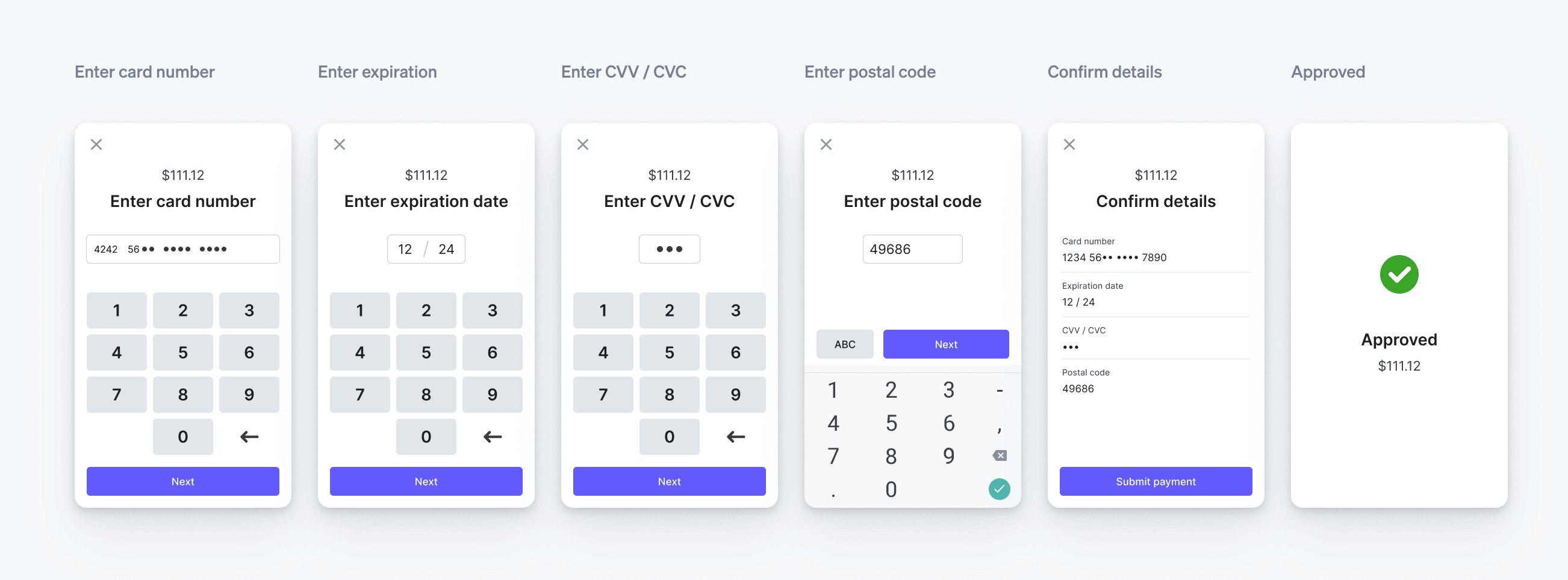虽然数字支付可能会受到更多关注,但 MOTO 支付(通过邮件和电话进行的支付)在支付生态系统中仍然占有重要地位。任何处理邮件和电话订单或正在考虑添加这些选项的商家都需要了解如何安全、战略性地部署 MOTO 支付。下面,我们将解释如何在数字支付的背景下处理 MOTO 支付。
本文内容
- 什么是 MOTO 支付?
- MOTO 支付的运作机制
- MOTO 支付的好处
- MOTO 支付的缺点
- 如何以商家身份接受 MOTO 付款
- MOTO 支付的费用是多少?
- MOTO 支付的最佳实践
- Stripe Terminal 如何提供帮助
什么是 MOTO 支付?
MOTO 支付是客户通过电话或邮件向商家提供支付银行卡信息的交易,而不是亲自或在线提交。首字母缩略词代表“邮购/电话订购”。当客户没有实体借记卡或信用卡时,商家使用这些交易来处理付款。MOTO 支付在电商兴起之前更为常见,尽管一些商家仍在使用它们。
如要进行 MOTO 付款,客户需提供他们的银行卡信息,商家将其输入支付系统以完成交易。此过程需要特定的协议来保证所提供支付信息的安全性和真实性。

MOTO 支付的运作机制
在线商务引入了技术先进的支付方式,这种支付方式比 MOTO 支付更安全且更便利。然而,MOTO 交易仍然与某些类型的商家和客户相关。尽管它们很简单,但它们需要注重细节并遵守安全协议,以降低风险并提供值得信赖的支付选项。
在商家因没有实体银行卡而处理信用卡或借记卡交易时,MOTO 支付才会发生。该过程通常采用如下运作机制:
客户决定通过电话或邮购表格进行购买。他们以口头或表格形式提供银行卡信息,包括银行卡号、有效期,有时还包括 CVV 代码。
然后,商家手动将此信息输入支付终端或虚拟终端——一种基于网络的支付平台,可通过计算机或可访问互联网的设备使用。
对于电话订单,企业可能会使用交互式语音应答 (IVR) 系统,提示客户使用电话键盘输入银行卡信息。这可以提高安全性,因为商家不直接处理银行卡信息。
输入详细信息后,支付处理商与卡组织和发卡行通信以授权交易。这包括检查银行卡的有效性、确保有足够的资金以及申请反欺诈措施。
授权之后,交易排队等待结算,资金被指定用于转账。但是,它们直到工作日结束时才会转账,届时商家将当天的所有交易发送到处理商进行结算。
结算时,资金从发卡行转账至商家账户,减去支付处理商收取的任何费用。此步骤可能需要几天时间,具体取决于支付处理商和相关银行。
MOTO 支付还可能涉及其他支付方式,例如客户发送纸质支票、提供他们用于银行转账的银行账户信息,甚至使用货到付款或售后发票付款。
无论您的商家使用哪种支付方式,您都应该保留完整的 MOTO 交易记录,以便保存记录和解决争议。这包括日期、金额、商品或服务的描述以及任何客户标识符。
MOTO 支付的好处
虽然 MOTO 支付并非对每种类型的商家都是必需的,但它们仍然与某些商家相关。请考虑合并 MOTO 支付对您的企业是否有意义。如果确实如此,这种支付类型可以带来巨大的好处,特别是在可访问性和市场覆盖范围方面。概览如下:
它们不需要互联网接入
MOTO 支付打破了互联网接入的障碍。这对于接触网络连接受限或没有网络连接的地区的客户,或不太愿意网上购物的老年人群尤为重要。通过提供电话或邮寄支付选择,商家可以为那些被排除在数字经济之外的人群提供服务。扩大客户群
通过适应不同的支付偏好,商家可以为客户提供选择并迎合他们的舒适度。这可以使其更易于吸引那些出于安全原因不愿在线输入卡信息的客户或那些只是喜欢通过电话与代表交谈的客户。与潜在客户的个人沟通
对于某些商业模式,例如高价商品或定制服务,深入的客户服务是关键,MOTO 支付可以带来更加个性化的交易。例如,在电话中,工作人员可以提供个性化的建议,追加销售额外的服务或产品,并建立融洽的关系,从而提高客户忠诚度。不依赖网站或结构化结账流程
在高峰时段或高客流量活动期间,商家可以快速处理订单,而无需客户等待网站页面加载。这可减少废弃购物车和销售额损失。
MOTO 支付仍受现代安全措施的约束。商家必须遵守严格的安全标准来保护客户信息,例如使用地址验证服务 (AVS) 和 CVV 验证,这可以让客户对他们的交易感到更安全。
MOTO 支付是对数字支付系统的补充,使商家能够提供传统和现代客户服务的组合,并展示对客户便利性和包容性的承诺。
MOTO 支付的缺点
MOTO 支付伴随着商家应考虑的风险和挑战,包括:
欺诈可能性增加
如果没有实体银行卡,就很难验证付款人是否是合法持卡人。欺诈行为者可能会尝试使用被盗的卡信息,因为他们知道没有必要出示银行卡本身。
缓解策略: 使用 AVS 等安全措施,并要求提供银行卡的 CVV 代码。此外,尽可能实施双重验证,例如向持卡人的手机发送确认码。
撤单与争议
MOTO 支付的撤单可能性更高,因为客户可能无法识别其对账单上的收款,或者声称他们从未授权过交易。
缓解策略: 保留交易和客户互动的详细记录。电话录音(在征得同意的情况下)和使用已签名的订单可为解决争议提供证据。
数据安全问题
通过电话或邮件处理敏感的支付信息涉及数据泄露和未经授权访问的风险。
缓解策略:遵守支付卡行业数据安全标准 (PCI DSS) 要求,对员工进行数据安全培训,并确保安全存储任何书面信息,然后在不再需要时妥善销毁。
手续费较高
由于风险增加,支付处理商通常会对 MOTO 交易收取更多费用。
缓解策略: 货比三家,选择费率具有竞争力的支付处理商,并根据您的交易量和您采取的安全措施协商费用。
运营挑战
接受 MOTO 付款可能需要员工在处理订单时付出更多努力,并且可能会减慢运营速度,尤其是在您遇到呼叫量较大的情况时。
缓解策略: 使用高效的接单系统(可能使用 IVR 接听电话)简化流程,并培训员工快速准确地处理交易。
有限的客户验证
很难执行某些可以亲自或通过数字交易进行的验证检查。
缓解策略: 实施其他专门设计用于 MOTO 支付的验证流程,并培训员工寻找订单中可能暗示欺诈活动的危险信号或不一致之处。
使用 MOTO 支付的商家必须主动了解这些风险,并努力采用策略来缓解它们。虽然 MOTO 支付更容易使用,但也需要提高警惕性并执行严格的安全协议来保护商家和客户。
如何以商家身份接受 MOTO 付款
设置 MOTO 支付意味着了解虚拟终端的作用。虚拟终端是允许商家手动输入通过电话或邮件收到的支付详细信息的在线应用程序。它们是零售店中使用的物理销售点 (POS) 终端的基于网络的安全版本,是处理这些交易的关键。
虚拟终端通过提供一种安全且高效的方式来远程输入和处理支付信息,从而促进 MOTO 支付。它们对于需要为无卡交易提供灵活、可靠解决方案的商家来说十分重要。它们还保留交易记录,商家可以轻松访问这些记录以进行报表制作、退款或撤单管理。
有兴趣接受 MOTO 支付的商家应将其视为为客户提供全面支付解决方案的总体战略的一部分。以下是接受 MOTO 付款的分步指南:
设置商家账户: 首先建立一个支持 MOTO 交易的商家账户。这属于银行账户的一种,可用于商家接受信用卡和借记卡支付。
选择支付处理商: 与支持 MOTO 支付的支付处理商合作。处理商应提供虚拟终端作为其服务的一部分。
执行安全检查: 确认虚拟终端符合 PCI DSS。设置额外的安全措施,例如 AVS 检查和 CVV 验证,以降低无卡交易的欺诈风险。
集成虚拟终端: 将虚拟终端集成到您的业务运营中。这可能涉及在多个工作站上设置虚拟终端和/或使远程团队也能访问虚拟终端。
培训员工: 培训您的团队使用虚拟终端。在处理敏感的客户信息时,他们应该了解如何处理支付并维护安全和隐私。
处理交易: 若要处理 MOTO 支付,请在虚拟终端中输入客户的支付详细信息,验证信息,然后提交授权。
授权交易: 虚拟终端与支付处理商通信以授权交易,确保银行卡有效且资金可用。
完成交易: 如果授权成功,请通过完成支付来完成交易,然后将资金结算到您的商家账户。
Stripe 为各种规模的企业提供金融互动,其虚拟终端设置为接受 MOTO 支付。使用 Stripe 处理这些交易时,需要遵循几个关键步骤:
创建 Payment Intent: 这是向 Stripe 系统声明您打算向客户的银行卡收费。在为 MOTO 支付设置 Payment Intent 时,您需要指定支付方式为银行卡。
处理支付: 使用 Stripe Terminal 或应用程序编程接口 (API),通过将其专门标记为 MOTO 交易来处理支付。这涉及在系统中输入持卡人的银行卡号、CVC、有效期及邮政编码。
验证读取器状态: 如果您使用的是硬件,则需要确保终端处于正确的状态(例如空闲、等待输入、处理交易或处于错误模式)以处理支付。
捕获付款: 若要完成交易,请捕获付款。如果 Payment Intent 状态为
requires_capture,则您必须确认捕获才能转移资金。
MOTO 支付的费用是多少?
接受 MOTO 付款的费用通常比其他银行卡支付略高。银行卡手续费包括交易金额的一定百分比,外加固定费用,由于欺诈风险增加,许多提供商对 MOTO 支付的收费比例更高。您可以了解有关 Stripe 的 MOTO 支付定价的更多信息。
MOTO 支付的最佳实践
对于 MOTO 支付,请考虑以下最佳实践:
语音认证: 实施语音认证技术。经客户同意,客户的声纹可用作电话交易的唯一验证工具,从而提高安全性。
来电线路识别: 使用来电线路识别功能,将来电与已知欺诈风险或以往欺诈交易的数据库进行比较,对潜在的风险来电立即作出提示。
动态货币兑换: 为您的国际客户提供动态货币兑换服务。这能让他们以本国货币查看或知晓购买金额,从而提升客户信任度与体验。
专用 MOTO 账户: 为 MOTO 交易设置专用商家账户,将其与其他销售渠道区分开来。这可以帮助您跟踪和更有效地管理潜在的欺诈。
回头客令牌化: 使用令牌化以安全地存储客户重复购买的支付信息。如果令牌被欺诈行为者拦截,就毫无用处。
自定义欺诈评分: 开发一套针对 MOTO 交易概况的欺诈评分系统,将购买规模、频率和订购模式中的任何异常情况等因素考虑在内。
智能呼叫路径: 智能呼叫路径可将回头客引向他们曾与之交谈过的代理。这些代理可以帮助检测常规客户的交易是否存在问题。
交易后分析: 使用数据分析进行交易后分析,以识别可能表明欺诈的模式。这可能包括分析下订单所需的时间、在提供信息时的任何犹豫或订单详细信息的不一致。
IVR 支付选项: 为不愿将银行卡信息直接提供给代理的客户提供 IVR 系统。这可以减少人为错误和数据泄露。
客户指导: 主动向客户介绍 MOTO 交易将如何进行,他们需要提供哪些信息,以及在不确定的情况下如何验证呼叫的合法性。
后续验证: 对于大额或不寻常的交易,请使用后续验证电话或发送带有唯一一次性代码的短信,客户必须提供该代码才能完成销售。
定期员工评估: 定期评估处理 MOTO 支付的员工,以确认他们遵循正确的安全协议。
PCI 合规: 接受 MOTO 付款的商家必须遵守 PCI DSS 以保护持卡人数据。这些标准包括安全地存储交易记录,以及在授权后不保留敏感的身份验证数据。
Stripe Terminal 如何提供帮助
Stripe Terminal 允许商家通过线下和在线渠道的一体化支付来增加收入。它支持新的支付方式、简单的硬件物流、全球覆盖以及数百个销售点和商务集成,以设计您理想的支付堆栈。您可以使用 Stripe Terminal 处理 MOTO 支付,只需在读卡器上输入银行卡信息,而无需点击或插入实体银行卡。
Stripe 为 Hertz、URBN、Lands' End、Shopify、Lightspeed、Mindbody 等品牌的一体化商务提供支持。
Stripe Terminal 可以帮助您:
一体化商务: 在全球平台上管理线上和线下付款,并提供统一的支付数据。
扩大全球规模: 通过一套集成和常用的支付方式,将规模扩大到 24 个国家/地区。
自定义集成: 开发自己的自定义销售点应用,或使用第三方销售点和商务集成与现有技术堆栈实现连接。
简化硬件物流: 轻松订购、管理和监控 Stripe 支持的读卡器,无论它们身在何处。
本文中的内容仅供一般信息和教育目的,不应被解释为法律或税务建议。Stripe 不保证或担保文章中信息的准确性、完整性、充分性或时效性。您应该寻求在您的司法管辖区获得执业许可的合格律师或会计师的建议,以就您的特定情况提供建议。